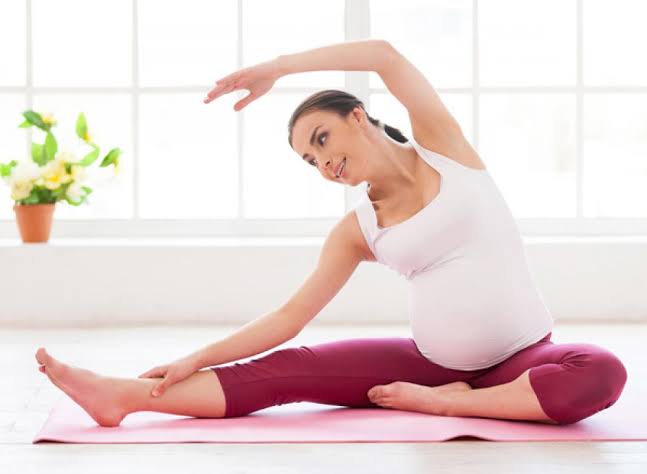Everyone understands that physical exercise is good for health. But some people have doubts about whether or not the practice is suitable for pregnant women. This article answers that yes!
With the exception of some specific cases of medical contraindication, the World Health Organization (WHO) recommendation is that pregnant women do at least 150 minutes of moderate physical activity per week. This includes aerobic and muscle strengthening activities.
However, it is important to take some precautions. The first of these is having medical clearance to exercise. Continue reading to find out more.
Importance of physical activity during pregnancy
 Even among previously sedentary pregnant women, starting with light activities already brings significant benefits to the health of the mother and baby.
Even among previously sedentary pregnant women, starting with light activities already brings significant benefits to the health of the mother and baby.
According to study physical exercises reduce the percentage of fat mass, increase the transfer of oxygen (O 2) and reduce the diffusion of carbon dioxide (CO 2 ) through the placenta, favoring the development fetal.
Furthermore, they benefit the health of the pregnant woman, reducing the risk of:
- Gestational diabetes mellitus (GDM)
- Preeclampsia (PE)
- Gestational hypertension (HG)
- Excessive weight gain
Depression
There are great reasons to exercise during pregnancy. But which exercises are best suited for pregnant women?
Best exercises for pregnant women
Among the aerobic exercises, the most recommended during pregnancy are: walking, exercise bike and swimming.
For muscle strengthening and pain reduction, Pilates, yoga, water aerobics and weight training are recommended. But no heavy loads, huh? In general, exercises done with your own body weight or with elastic bands already achieve good results.
Pelvic floor strengthening exercises are also recommended throughout pregnancy, both to prepare for childbirth and to reduce the risk of pre- and postnatal urinary incontinence.
Also read: How to do kegel exercises for women to Improve sexual health
Exercises not recommended for pregnant women
- Contact sports (football, basketball, volleyball, fights), with a risk of falling (horse riding, skating, cycling), etc.
- Intense running and exercises that require a lot of strength.
Exercises for pregnant women in the 1st trimester
In the first trimester of pregnancy (weeks 1 to 13), it is common to experience more tiredness, drowsiness and nausea. Blood pressure may drop too. Therefore, it is normal for pregnant women who have already exercised before to reduce the intensity. Don’t cover yourself! Among those who were sedentary before pregnancy, the beginning should be very light.
Care: from the 10th week of pregnancy there is a significant increase in relaxing levels, a hormone that makes the pregnant woman’s joints and ligaments more flexible for childbirth. Because of this, extreme stretching should be avoided to prevent injuries.
Exercises for pregnant women in the 2nd trimester
The second trimester of pregnancy (between weeks 14 and 26) is usually the busiest period for pregnant women. Nausea and nausea are less frequent and blood pressure tends to stabilize. Those who were practicing light intensity activities can usually progress to moderate activities.
Tip to know if physical activity is moderate
In addition to heart rate calculations carried out with professional help, it is possible to do a home speech test (talk test): in this test, breathing becomes a little labored, making it possible to talk during the exercise (one sentence without pauses), but not sing.
Cautions: exercising in the supine position (on your back) may be less comfortable and safe. Prefer the position lying on your side or standing up. Also avoid abdominal exercises, due to the risk of increasing abdominal diastasis.
Exercises for pregnant women in the 3rd trimester
In the third trimester (between weeks 27 and 40), the pressure of the uterus on the aorta and superior vena cava increases, which may also increase blood pressure. It’s time to reduce the intensity of physical activities. But you don’t need to stop!
For this final stretch of pregnancy, it is recommended to do preparatory exercises for childbirth, such as hip mobility, stretching and squats.
General precautions for exercise during pregnancy
Are you or do you know a pregnant woman exercising?
Excellent! But, before you start, check out some precautions to make the practice safer and more enjoyable:
- Get prenatal care
- Avoid exercising in hot environments
- When outdoors, prefer cooler temperature times (before 10am or after 4pm)
- In water sports, keep the water temperature at up to 34°C
- Eat a light meal 30 to 60 minutes before practice
- Drink fluids before and after to ensure good hydration
Situations in which you should stop exercising during pregnancy and seek medical advice
Short breathing, which does not return to normal with:
- Rest;
- Headaches;
- Regular and painful uterine contractions;
- Vaginal bleeding;
- Continuous loss of amniotic fluid;
- Fainting or persistent dizziness;
- Chest pain;
- Palpitations;
- Visual disturbances;
- Persistent nausea and vomiting;
- Muscle weakness affecting balance; or other discomfort that makes activity impossible.
Very important: the explanations described in this article do not replace medical consultation and prenatal care throughout the pregnancy. Talk to your doctor and don’t be shy about asking questions. Learn more about pregnancy by tapping this link.








